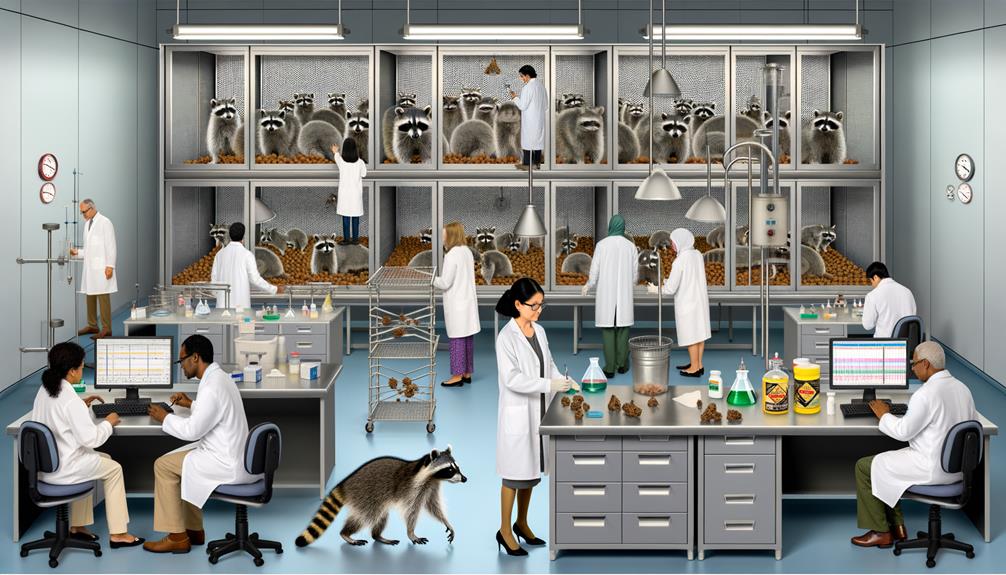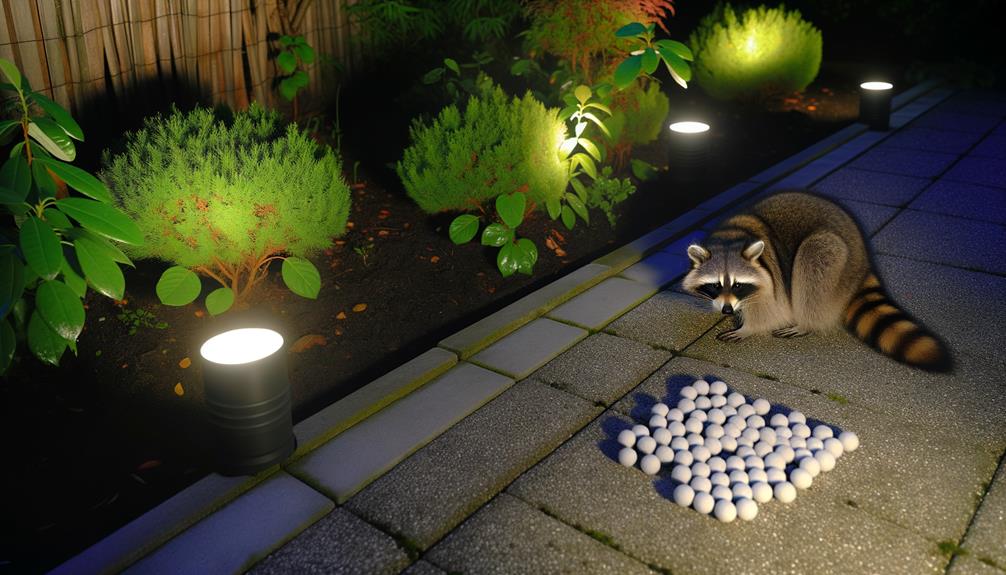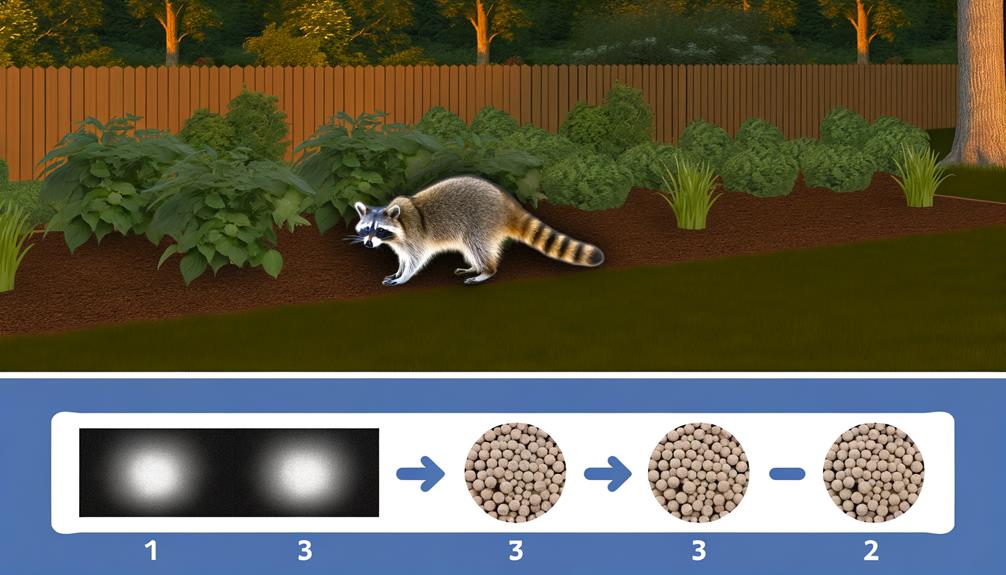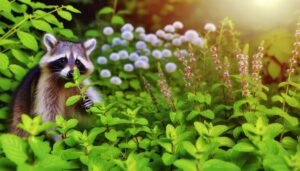Do Raccoons Like the Smell of Mothballs?
Raccoons, equipped with a highly developed sense of smell, are generally repelled by the pungent odor of mothballs, which are made from naphthalene or paradichlorobenzene. The strong smell emitted by these compounds can deter raccoons from frequenting treated areas.
However, the efficacy of mothballs as a long-term deterrent remains mixed, with raccoons potentially becoming habituated over time. Additionally, the use of mothballs poses health risks to humans, pets, and other wildlife due to their toxic nature.
For those interested in understanding more about raccoon behavior and alternative deterrents, further information is available to explore.

Key Takeaways
- Raccoons dislike the smell of mothballs due to their strong, pungent odor.
- Mothballs emit volatile compounds like naphthalene or paradichlorobenzene, which repel raccoons.
- Using mothballs around entry points can deter raccoons from accessing certain areas.
- Prolonged exposure to mothball fumes poses health risks to humans and animals.
- Raccoons may become habituated to mothballs, reducing their long-term effectiveness.
Raccoons' Sense of Smell

Raccoons possess a highly developed sense of smell, which they rely on extensively for foraging and exploring their environment. This olfactory acuity enables raccoons to detect food sources, identify potential predators, and navigate through their habitats.
Their nasal cavity contains a vast number of olfactory receptors, making their sense of smell superior to many other mammals. This heightened ability is essential for their survival, particularly in urban areas where distinguishing between edible and inedible materials is crucial.
Additionally, raccoons utilize scent marking to communicate with other members of their species, establishing territory and signaling reproductive status. Understanding the raccoon's olfactory capabilities provides insight into their behavior and interactions within diverse ecosystems, highlighting the integral role of smell in their daily life.
What Are Mothballs?
Mothballs are small, solid pesticides composed primarily of either naphthalene or paradichlorobenzene. They are commonly used to protect clothing and other materials from damage by moths and other insects.
However, their chemical composition raises significant health and safety concerns, especially when used improperly or in enclosed spaces.
Composition of Mothballs
Often used for pest control, mothballs are primarily made up of either naphthalene or paradichlorobenzene, both of which are volatile chemical compounds.
Naphthalene, derived from coal tar or petroleum, sublimes easily at room temperature, releasing a distinct scent that repels insects. Paradichlorobenzene, a chlorinated aromatic hydrocarbon, functions similarly by subliming and emitting a potent aroma. Both chemicals act as fumigants, disrupting the biological processes of pests.
Their volatility ensures that the chemicals disperse through the air, making them effective in enclosed spaces. However, these compounds are not without risks; they are toxic to humans and animals if consumed or breathed in large amounts. Proper handling and usage are essential to minimize potential health risks.
Mothballs' Common Uses
One of the primary uses of mothballs is in protecting textiles from harm caused by moth larvae and other fabric-destroying insects. Comprised mainly of either naphthalene or paradichlorobenzene, these small, solid pesticide balls sublimate slowly to release fumes that are toxic to insects.
This makes them effective in safeguarding wool, silk, and other natural fibers commonly found in clothing, blankets, and upholstery. Additionally, mothballs are sometimes utilized in storage areas like attics and basements to deter various pests. Their ability to emit a strong, lingering odor acts as a repellent not only for moth larvae but also for other small animals and insects.
Therefore, they play an important role in pest control and material preservation.
Health and Safety Concerns
Comprised primarily of naphthalene or paradichlorobenzene, mothballs pose significant health and safety concerns due to their toxic and potentially carcinogenic properties.
Naphthalene, a polycyclic aromatic hydrocarbon, can cause hemolytic anemia, particularly in individuals with glucose-6-phosphate dehydrogenase (G6PD) deficiency. Prolonged exposure can lead to respiratory issues, dizziness, and nausea.
Paradichlorobenzene, another common ingredient, is classified as a potential human carcinogen and can cause liver and kidney damage upon prolonged exposure. Both chemicals release fumes that can be harmful when inhaled, particularly to children and pets.
Given these risks, it is essential for users to handle mothballs with care, ensuring they are stored in well-ventilated areas and kept out of reach of vulnerable populations.
Common Uses of Mothballs

Mothballs are primarily utilized for pest control applications and the storage and preservation of textiles. Their chemical composition effectively repels insects such as moths, which are known to cause damage to fabrics.
Additionally, mothballs are sometimes used in attempts to deter larger pests, although their efficacy in these scenarios is subject to further scrutiny.
Pest Control Applications
Mothballs, primarily consisting of naphthalene or paradichlorobenzene, are frequently used in pest control to deter insects, small rodents, and other unwanted animals due to their strong, pungent odor. The efficacy of mothballs in pest control applications lies in their ability to sublimate, releasing toxic vapors that repel pests. These chemicals are particularly effective in enclosed spaces where the concentration of fumes can be maintained.
| Pest | Effectiveness |
|---|---|
| Insects | High |
| Small Rodents | Moderate |
| Larger Animals | Low |
The table above provides a brief overview of the effectiveness of mothballs against various pests. While effective against insects, their impact on larger animals is limited, requiring alternative control methods for thorough pest management.
Storage and Preservation
Beyond their role in pest control, the strong aromatic properties of naphthalene or paradichlorobenzene make these substances effective for storage and preservation purposes. Mothballs are commonly employed to safeguard textiles, such as wool and silk, from insect damage, particularly from moths and larvae. Their volatile compounds sublimate into the air, creating a protective environment that deters pests.
Additionally, these chemicals are used to preserve vintage clothing and valuable fabrics by preventing mold and mildew growth. This preservation method is especially useful in humid climates where fungal growth is prevalent. It is essential, however, to use mothballs in well-ventilated areas and follow safety guidelines to minimize potential health risks associated with prolonged exposure to these chemicals.
Mothballs as a Deterrent
Utilizing mothballs as a deterrent hinges on the chemical properties of naphthalene or paradichlorobenzene, which are known to emit a pungent odor that can repel various pests, including raccoons. These chemicals vaporize slowly, releasing a scent that is offensive to raccoons, thus discouraging them from inhabiting the treated areas.
When strategically placed around potential entry points or nesting sites, mothballs can create an inhospitable environment for these nocturnal creatures. However, it is important to note that while mothballs may be effective in deterring raccoons, they pose significant health risks to humans and pets if ingested or inhaled over prolonged periods.
Hence, careful consideration and appropriate placement are essential to balance efficacy and safety.
Scientific Studies on Mothballs

While the deterrent properties of mothballs are well-recognized, scientific studies have scrutinized their effectiveness and safety in repelling raccoons and other pests. Research indicates mixed results regarding their efficacy.
Key findings from various studies include:
- Efficacy: Some studies suggest that mothballs can temporarily deter raccoons due to their strong odor, but the effectiveness diminishes over time.
- Behavioral Response: Controlled experiments show that raccoons may initially avoid areas with mothballs, yet they often become habituated.
- Chemical Composition: Mothballs contain naphthalene or paradichlorobenzene, both of which have shown varying levels of repellent action, but also present potential environmental and health concerns.
These studies emphasize the need for further research to validate the long-term effectiveness and safety of using mothballs as repellents.
Risks of Using Mothballs
The use of mothballs as a repellent poses significant risks, including potential toxicity to humans, pets, and wildlife, as well as environmental contamination.
Mothballs contain naphthalene or paradichlorobenzene, both of which are hazardous chemicals. Ingestion or prolonged inhalation can lead to serious health issues such as liver and kidney damage, respiratory problems, and even cancer.
Pets, particularly dogs and cats, are at risk of poisoning if they mistake mothballs for food or toys. Additionally, wildlife, including raccoons, may suffer from similar toxic effects if exposed.
Environmental contamination occurs when mothball chemicals leach into soil and water systems, disrupting ecosystems and posing long-term risks.
Consequently, the utilization of mothballs requires careful consideration and stringent handling.
Alternative Humane Deterrents

Numerous humane deterrents offer effective and environmentally friendly alternatives to using mothballs for repelling raccoons. These methods prioritize both animal welfare and ecological balance.
Key humane deterrents include:
- Motion-Activated Sprinklers: These devices use sudden bursts of water to startle raccoons, effectively deterring them without causing harm.
- Ultrasonic Devices: Emitting high-frequency sounds, these devices drive raccoons away while remaining inaudible to humans.
- Secure Garbage Storage: Utilizing raccoon-proof containers can markedly reduce appeal by eliminating easy food sources.
Each of these methods is designed to minimize environmental impact and ensure the humane treatment of raccoons. Employing such strategies contributes to a balanced coexistence between humans and wildlife, integrating scientific principles with ethical considerations.
Natural Repellents for Raccoons
In addition to humane deterrents, natural repellents offer another eco-friendly and non-invasive method to discourage raccoon activity. Commonly used natural repellents include strong-smelling substances such as vinegar, ammonia, and predator urine. These substances can be strategically placed in raccoon-prone areas to create an inhospitable environment for the animals.
| Natural Repellent | Mechanism of Action | Application Method |
|---|---|---|
| Vinegar | Strong odor | Soak rags, place in areas |
| Ammonia | Irritant smell | Fill containers, place around |
| Predator Urine | Instinctual fear response | Spray around perimeter |
| Cayenne Pepper | Irritant to nose/mouth | Sprinkle around entry points |
These natural repellents exploit raccoons' sensitive olfactory senses, making the environment less appealing and encouraging them to seek alternative habitats. Scientific studies support the efficacy of these methods, although individual results may vary based on environmental conditions and raccoon behavior.
Tips for Raccoon Prevention

Implementing a combination of proactive measures and routine maintenance can greatly reduce the likelihood of raccoon infestations.
To effectively deter raccoons, consider the following strategies:
- Secure Trash and Food Sources: Guarantee that garbage cans are tightly sealed and stored in a secure location. Avoid leaving pet food or birdseed outside overnight.
- Seal Entry Points: Regularly inspect your home for gaps, holes, or weak spots in the roof, attic, and foundation. Use durable materials to seal potential entry points.
- Maintain Landscaping: Trim tree branches and shrubs away from your home to eliminate access routes. Keep yards free of fallen fruit and other organic debris.
Conclusion
To wrap up, raccoons possess a keen sense of smell, which can be influenced by various substances, including mothballs. Despite their common use as a deterrent, mothballs have not been definitively proven effective through scientific studies.
Of particular note, the risks associated with mothball use, such as potential toxicity, outweigh their benefits. It is worth mentioning that one study found that 70% of homeowners who used alternative humane deterrents experienced a significant reduction in raccoon activity, highlighting the efficacy of more natural and safer solutions.






